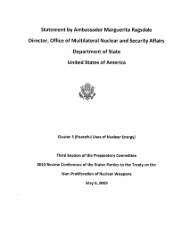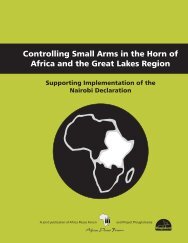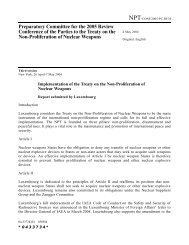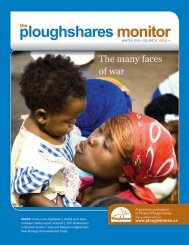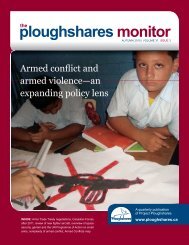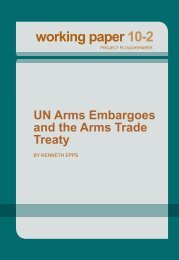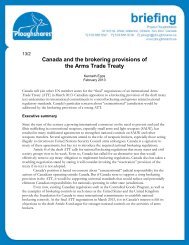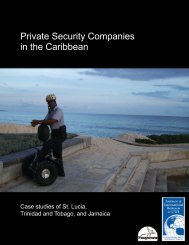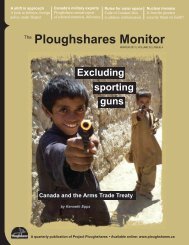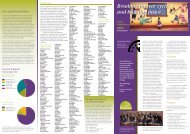Addressing Armed Violence in East Africa.pdf - Project Ploughshares
Addressing Armed Violence in East Africa.pdf - Project Ploughshares
Addressing Armed Violence in East Africa.pdf - Project Ploughshares
Create successful ePaper yourself
Turn your PDF publications into a flip-book with our unique Google optimized e-Paper software.
<strong>Address<strong>in</strong>g</strong> <strong>Armed</strong> <strong>Violence</strong> <strong>in</strong> <strong>East</strong> <strong>Africa</strong>4. Ugandachildren and to attend to their psychological problems. WVUestablished centres for returned children to replace hold<strong>in</strong>gcentres <strong>in</strong> government army barracks. (We were told that thearmy paraded the rescued children – and adults – dur<strong>in</strong>g publicrallies for relatives to identify and take them home.) The hold<strong>in</strong>gcentres not only were illegal (Uganda is a signatory to the UNConvention on the Rights of the Child) but came under attackfrom the LRA <strong>in</strong>tent on recaptur<strong>in</strong>g “their soldiers”. 12The WVU centres became way stations for children betweenthe bush where the LRA operated and their home communities.The children were given therapy and skills tra<strong>in</strong><strong>in</strong>g and therewere sensitisation programmes for their communities of return.World Vision also became a conduit for advocacy for returnedchild soldiers, who spoke <strong>in</strong> Canada (at the InternationalConference on War-Affected Children held <strong>in</strong> W<strong>in</strong>nipeg <strong>in</strong>September 2000) and at other <strong>in</strong>ternational forums about theconflict <strong>in</strong> Uganda.Peacebuild<strong>in</strong>g is not mean<strong>in</strong>gfulon an empty stomach.World Vision staff expla<strong>in</strong>ed that the Area DevelopmentProgramme (ADP) <strong>in</strong> Kitgum district began <strong>in</strong> 1995, fundedthrough child sponsorship, and cont<strong>in</strong>ues to this day. (An ADPis the primary vehicle through which World Vision facilitatescommunity development; it is a long-term developmentprogramme [usually 10–15 years] implemented across acontiguous geographic area, cover<strong>in</strong>g numerous sectors of<strong>in</strong>tervention.) 13 S<strong>in</strong>ce its <strong>in</strong>ception, Kitgum ADP has <strong>in</strong>tervened<strong>in</strong> various sectors, <strong>in</strong>clud<strong>in</strong>g emergency relief; water andsanitation; HIV and AIDS prevention, care and support;education; and support to agricultural production. In Sorotidistrict, the World Vision Uganda-assisted Tubur ADP began<strong>in</strong> 2000. It has undertaken <strong>in</strong>terventions <strong>in</strong> the key areas ofagriculture, health, education and HIV/AIDS. The Tubur ADPwas disrupted and people displaced by LRA activities <strong>in</strong> 2003.Renewal of ADP activity had to await the beg<strong>in</strong>n<strong>in</strong>g of peacetalks <strong>in</strong> 2006.We now consider the peacebuild<strong>in</strong>g projects <strong>in</strong> each district.Kitgum districtThe WV peacebuild<strong>in</strong>g project <strong>in</strong> the Kitgum district (theKitgum Reconciliation and Economic Recovery <strong>Project</strong>) beganwhen problems arose among the people displaced by violentLRA activities <strong>in</strong>to IDP camps (see Box 4.3.1). In the camps,<strong>in</strong>ter-family and <strong>in</strong>ter-communal conflict arose because thetraditional social structures among the Acholi people haderoded. Children return<strong>in</strong>g from <strong>in</strong>surgent activities wereblamed for LRA atrocities. There was a need for reconciliationwith<strong>in</strong> and between communities.The WV peacebuild<strong>in</strong>g project <strong>in</strong> Kitgum had two phases. Thefirst phase, from 2004–2006, <strong>in</strong>volved several components.A central component focussed on children, many of whomwere born dur<strong>in</strong>g the period of the <strong>in</strong>surgency, to <strong>in</strong>culcate aculture of peace. The activities <strong>in</strong>cluded competitive “peacedebates” between schools, peace games and peace clubs. Anothercomponent focussed on youth <strong>in</strong> and out of high school byengag<strong>in</strong>g them <strong>in</strong> sports, rallies and marches, and speeches forpeace, mak<strong>in</strong>g use of the United Nations International PeaceDay. The work with youth also <strong>in</strong>cluded music and dramathat was showcased <strong>in</strong> communities. In addition, women wereorganised <strong>in</strong>to groups engaged <strong>in</strong> reconciliation, us<strong>in</strong>g songs andtraditional dances for peace. A general peace dialogue was aimedat male leaders. A capacity-build<strong>in</strong>g component used traditionalstructures for peace. Traditional cultural leaders and faith-basedleaders were engaged. Local community capacity was builtthrough mediation and tra<strong>in</strong><strong>in</strong>g <strong>in</strong> negotiation skills. Similartra<strong>in</strong><strong>in</strong>g was also given to lower-level government officials.The second phase of the peacebuild<strong>in</strong>g project was built on thelessons learned from evaluation of the first. A key lesson wasthat “peacebuild<strong>in</strong>g is not mean<strong>in</strong>gful on an empty stomach”,that is, peacebuild<strong>in</strong>g undertaken <strong>in</strong> very poor communities isnot susta<strong>in</strong>able. Moreover, the conflicts that arose over access toland became more prom<strong>in</strong>ent as improved security encouragedmore people to return to their home communities. Based ona needs analysis, the project’s second phase was consequentlyoriented toward <strong>in</strong>come generation, group <strong>in</strong>teraction andcohesion, and the resolution of land disputes. The project alsoexpanded to cover five sub-counties.12 Accord<strong>in</strong>g to a World Vision Uganda report, Promot<strong>in</strong>g a Culture of Peacewith Partners: Peacebuild<strong>in</strong>g Report 2008, “In March 1995, <strong>in</strong> collaborationwith the government of Uganda, World Vision opened the Children of WarRehabilitation Centre <strong>in</strong> Gulu which later expanded to four centres (three <strong>in</strong>Gulu and one <strong>in</strong> Pader)” (p 13).13 A full def<strong>in</strong>ition of an ADP is provided <strong>in</strong> the Glossary.44



